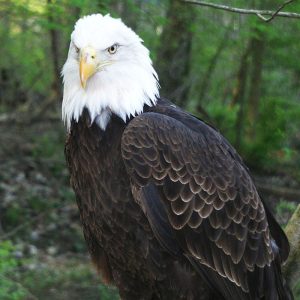Great Horned Owl – Cecil
Cecil was originally an education ambassador for a small Rehabilitator run education program in Mississippi. When the owner passed away, her educational ambassadors needed to find new homes, and Cecil (then CC) ended up at World Bird Sanctuary. A little unsure at first, he very quickly warmed up to his new home and all his new trainers! In fact one of his favorite activities is attempting to build nests for all his human friends!
$29.00 – $129.00
Description
HATCH YEAR: PRIOR TO 2009
FUN FACTS ABOUT CECIL
- A very talkative owl, Cecil quickly became a guest favorite during our Owl Prowl programs where he does his best to talk over the program speaker. He hoots often when sitting on his trainer’s glove, and also loves his crate. It is usually challenging for his trainers to get him to come out of his crate for programs, unless he is encouraged with a tasty bite of meat. Whoo wouldn’t want to work for a snack like mice?!
- Cecil regularly travels off-site to schools and overnight programs where he continues to educate people about native wildlife and give the PERFECT example of what a Great Horned Owl sounds like to anyone, at any time!
SPECIES FACTS
Scientific Name:
- Bubo virginianus.
Distribution:
- Highly distributed throughout most of North and South America.
Habitat:
- Wide variety of wooded habitat; forests, swamps, deserts, rocky areas, farmland and urban areas from sea level to 12,000 feet.
Diet:
- Small to medium mammals, birds, amphibians, reptiles, fish insects, and occasionally carrion if other food is scarce; one of the few animals known to prey on skunks due to their lack of a sense of smell.
Behavior:
- Hunts at dusk and during the night from a perch, while flying low over the ground, walking on the ground, or wading into water; among the earliest breeding birds in North America; territories are claimed in the fall, and breeding takes place in January or early February; nesting is done in other birds’ stick nests, natural tree hollows, man-made platforms, or on cliff ledges or cave entrances; female lays 1-3 eggs and incubates for 26-35 days; young birds start to wander away from the nest in 6-7 weeks at which point they are called “branchers”; they are fully flighted at 10-12 weeks; fledglings are tended by the parents for up to 5 months; maturity is reached at 2 years.
Identification:
- Largest owl native to North America; adults have large ear tufts which are not actually ears, but large tufts of feathers; face is reddish, brown or gray with a white patch on the throat; iris is yellow; underparts are light with brown barring; upper parts are mottled brown; legs and feet are feathered up to the talons; owls have binocular vision and the ability to turn their heads a full 270 degrees; an owl’s hearing is as good as, if not better, than its vision; owls have stereo hearing which allows them to triangulate the location of prey.
Additional information
| Adoption Level | Fan, Friend, Sponsor |
|---|
Related products
-

Bald Eagle – Patriot
$29.00 – $129.00 Select options This product has multiple variants. The options may be chosen on the product page -

Bald Eagle – Clark
$29.00 – $129.00 Select options This product has multiple variants. The options may be chosen on the product page




